
/6,).'1%%.3!3%.)5%12)38/6,).'1%%.3!3%.)5%12)38
#(/,!1 /1+2#(/,!1 /1+2
/./121/*%#32 34$%.3#(/,!12()0
01).'
70,/1!$/1%2$%$)/-!2)'(#(//,%$0!.)2(%22/.270,/1!$/1%2$%$)/-!2)'(#(//,%$0!.)2(%22/.2
!41%.%"1).'
,2%"1)."'24%$4
/,,/63()2!.$!$$)3)/.!,6/1+2!3(33022#(/,!16/1+2"'24%$4(/./1201/*%#32
!13/&3(%),).'4!,4,3),).'4!,!.$4,3)#4,341!,$4#!3)/./--/.2!.$3(%!.'4!'%!.$
)3%1!#8$4#!3)/./--/.2
/6$/%2!##%223/3()26/1+"%.%:38/4%342+./6/6$/%2!##%223/3()26/1+"%.%:38/4%342+./6
%0/2)3/18)3!3)/.%0/2)3/18)3!3)/.
%"1).'!41%.70,/1!$/1%2$%$)/-!2)'(#(//,%$0!.)2(%22/.2
/./121/*%#32
(33022#(/,!16/1+2"'24%$4(/./1201/*%#32
()26/1+)2"1/4'(33/8/4&/1&1%%!.$/0%.!##%22"83(%34$%.3#(/,!12()0!3#(/,!1 /1+23(!2
"%%.!##%03%$&/1).#,42)/.)././121/*%#32"8!.!43(/1)9%$!$-).)231!3/1/&#(/,!1 /1+2

EXPLORADORES DE IDIOMAS: HIGH SCHOOL LED SPANISH LESSONS
LAUREN SEBRING
HONORS PROJECT
Submitted to the Honors College at Bowling Green State University in partial fulfillment of the
requirements for graduation with UNIVERSITY HONORS
23 APRIL 2024
Brigid M. Burke, Ph.D.
World Language Education
Margaret Z. Booth, Ph.D.
Educational Foundations, Leadership, and Policy

EXPLORADORES DE IDIOMAS: HIGH SCHOOL LED SPANISH CLASSES 1
Introduction
As our world is becoming ever more international, it is very important that each
individual in the United States of America works toward becoming a global citizen. According to
the United Nations,
Global citizenship is the umbrella term for social, political, environmental, and economic
actions of globally minded individuals and communities on a worldwide scale. The term
can refer to the belief that individuals are members of multiple, diverse, local and non-
local networks rather than single actors affecting isolated societies. Promoting global
citizenship in sustainable development will allow individuals to embrace their social
responsibility to act for the benefit of all societies, not just their own (Global Citizenship,
n.d).
Based on this quote, global citizens should be people who are curious, intelligent, open-minded,
and want the best for all societies around them. However, how can individuals become global
citizens? In my experience, one of the best ways to become a global citizen is to learn more than
one language. Being bilingual allows individuals to communicate with more people around the
world and introduces them to cultures different from their own. When individuals can
communicate with a broader range of people, they have opportunities to learn even more. They
can learn about different ways of life, different experiences, different cultures, and more. It
allows them to talk to many more people and hear from them. Based on these new stories and
experiences, individuals may be required to reconsider some prior thoughts and opinions. The
prior reasons are just a few of many reasons why it is important to be bilingual. To better

EXPLORADORES DE IDIOMAS: HIGH SCHOOL LED SPANISH CLASSES 2
understand how to educate U.S. students to be global citizens, this applied research project will
investigate how cities can begin to incorporate small language programs into their communities
in order to create more opportunities for students to become bilingual and develop global
competence. In reviewing the literature and based on my experience as a pre-service teacher with
fifth graders in a local catholic elementary school during 2023 and 2024, these are the research
questions I will explore during this project in order to create the Exploradores de Idiomas
program proposal that I would like to implement as a high school Spanish teacher.
My research questions are:
● Why should individuals be bilingual?
● How can we increase the number of bilingual individuals in the United States?
● How can we improve world language teaching to achieve language proficiency?
Literature Review
Why Study World Languages?
World language education exposes students to different cultures, promotes cultural
heritage, encourages connection between schools and their communities, and creates an
environment of respect for all (Jaumont, 2019, p. 1). This helps students keep an open mind and
continue to develop feelings of empathy and inclusion, while learning more about the world
around them (EL Education, 2018). World language (WL) education also helps maintain the
different cultures within communities in the United States, and even bring new cultures to local
communities. According to Austin (2002), there are many reasons why people in the U.S. in
particular should study world languages. Austin suggests that people should learn world
languages in order to increase cultural sensitivity, enhance travel enjoyment, refine English
EXPLORADORES DE IDIOMAS: HIGH SCHOOL LED SPANISH CLASSES 3
grammar through language comparison, understand roots of words, and expand employment
opportunities (Austin, 2002). In conclusion, there are many benefits to studying and learning
another language. This literature review will explore the decrease in world language programs,
the world language teacher shortage, and the evolution in world language educational methods.
After reviewing the literature, a potential solution to remedy the decline in world language
education will be provided.
Decline in World Language Programs and Teachers
The number of language programs in schools and universities is rapidly declining in the
United States (Quinn, 2023). As of recently, the United States has been experiencing a
significant teacher shortage (Burke & Ceo-DiFrancesco, 2022). As a result of this, many schools
and universities have been eliminating their language programs. According to UToday News, the
University of Toledo announced that are suspending admissions for the world language programs
in preparation to close the many of the world language programs within the coming years
(Cunningham, 2024, p. 1). In 2023, West Virginia University (WVU) also cut language majors
from their program. WVU did keep some face-to-face WL classes, however there are not enough
classes for students to pursue a major in these languages (Anderson, 2023, p. 1). This is a new
epidemic that is beginning to affect many schools across the country. Numerous educators,
students, and parents are wondering why these programs are getting cut. Burke and Ceo-
DiFrancesco (2022) explored reasons why world language (WL) educators choose to study a
world language and become world language teachers. They discuss recruitment tactics at
Bowling Green State University and Xavier University that increased enrollment in WL
EXPLORADORES DE IDIOMAS: HIGH SCHOOL LED SPANISH CLASSES 4
education programs in addition to other factors that helped increase WL education program
enrollment, and what practices increased the retention of students in the teacher program.
Burke and Ceo-DiFrancesco (2022) discuss why there is a shortage of WL teachers. In
their literature review, they present several factors for the shortage of US WL teachers including
increased student enrollments, teacher retirements, teacher attrition, legislation, negative
perceptions of the profession, increased accountability for teacher education programs, and
increased testing for WL education majors (Burke & Ceo-DiFrancesco, 2022, p. 334). These are
all important factors that the public should keep in mind as language programs around the US
continue to decline.
The public should be concerned about the WL teacher shortage in particular because it
impacts the future success of students in our society as it continues to change globally. The
success of students is pertinent in relation to education, since the goal of the education system is
to prepare students for success. In order to accomplish this goal, it is crucial that educators,
students, and society continue to grow and change their ideas as education and society progress.
As a way to combat the decline in WL education, the public should keep themselves informed
and remember why WL education is important. Additionally, the public should learn as much as
they can about WL education and methods with the aim of preserving remaining WL programs.
Change in Educational Methods
Now, the question that many people have after learning about the WL teacher shortage
and the elimination of university language programs is as follows: How can we, as a society,
change our view of world language education in order to increase the number of bilinguals in our
communities? As of recently, the world language education profession has seen a shift towards
EXPLORADORES DE IDIOMAS: HIGH SCHOOL LED SPANISH CLASSES 5
communicative language teaching (CLT) and proficiency instead of traditional language teaching
with a focus on grammar and translation (Burke, 2006). ACTFL (2010) recommends teachers
use the target language at least 90% of the time to develop students’ communicative proficiency.
According to Savignon (2002), communicative language teaching is based on
“communicative competence” (Savignon, 2002, p 1). Savignon (2002) defines competence as,
“... the expression, interpretation, and negotiation of meaning and looks to both psycholinguistic
and sociocultural perspectives in second language acquisition (SLA) research to account for its
development” (Savignon, 2002, p. 1).
CLT is based on eight major principles from Berns (1990), which are as follows:
1. Language teaching is based on a view of language as communication. That is,
language is seen as a social tool that speakers use to make meaning; speakers
communicate about something to someone for some purpose, either orally or in writing.
2. Diversity is recognized and accepted as part of language development and use in
second language learners and users, as it is with first language users. 3. A learner’s
competence is considered in relative, not in absolute, terms. 4. More than one variety of a
language is recognized as a viable model for learning and teaching. 5. Culture is
recognized as instrumental in shaping speakers’ communicative competence, in both their
first and subsequent languages. 6. No single methodology or fixed set of techniques is
prescribed. 7. Language use is recognized as serving ideational, interpersonal, and textual
functions and is related to the development of learners’ competence in each. 8. It is
essential that learners be engaged in doing things with language – that is, that they use
language for a variety of purposes in all phases of learning (Berns, 1990, p 104).
EXPLORADORES DE IDIOMAS: HIGH SCHOOL LED SPANISH CLASSES 6
Based on these key principles, teachers and students can incorporate CLT methods into their
classrooms. A very important idea from these principles is comprehensible input, which is
defined as the amount of a world language that a learner can understand without problem, as well
as new information which would be incomprehensible without context or being embedded in
familiar language (Krashen, 1982, p. 9). Krashen’s theory of comprehensible input has been
integral to second language acquisition theories to explain how students can work towards
proficiency in their world language.
One educational approach that can be used for world language education is Expeditionary
Learning. According to EL Education (2018), “Expeditionary learning is an engaging
educational approach at the heart of our work that emphasizes authentic, multidisciplinary,
experiential learning and the integration of rigorous academic content with real-world
experiences.” (EL Education, 2018, p.1). Schools such as Capital City Public Charter School,
Codman Academy Public Charter School, World of Inquiry School, Flint Cultural Center
Academy, and more use Expeditionary Learning design to develop their curriculum.
Expeditionary Learning schools integrate curriculum, which is where teachers, such as for
Spanish and for social studies, teach classes and/or plan curriculum and projects together (EL
Education, 2018). There also are specific schools with immersion programs, such as Spanish
Immersion school in Mansfield, Ohio and Columbus Spanish Immersion Academy K-8. These
programs are effective for students since they are surrounded by the language and culture every
day for a certain period of time. According to EL Education (2018), a curriculum that allows
students to learn about real-world issues through learning expeditions, case studies, etc. allows
students to become inspired and contribute to the community (EL Education, 2018, p. 5). In
EXPLORADORES DE IDIOMAS: HIGH SCHOOL LED SPANISH CLASSES 7
conclusion, there are a lot of changes occurring in relation to world language education in order
to push for proficiency in the target language. In order to achieve this, the following program
proposal suggests a possible solution.
Exploratory Programs
Knell and Chi (2012) found that, “immersion students used in this study had significantly
higher levels of willingness to communicate and perceived competence and exhibited less
language anxiety than their nonimmersion peers.” (p. 1). In order to collect data about the
success of the immersion program versus the nonimmersion program, Knell & Chi’s students
participated in both group testing and individual testing. The individual test gauged students’
skills related to speaking, vocabulary, and word identification. For group testing, students were
given a questionnaire that focused on students’ attitudes towards language learning. After the
questionnaire, students were given a reading comprehension in order to see the effect of student
attitudes on the comprehension outcome. While Knell & Chi did not find many differences
between immersion and nonimmersion students for motivation and parent support, they did find
a large difference between immersion and nonimmersion students’ language performance
variables (oral and reading). Knell & Chi found that the immersion students did much better
when tested on speaking and reading when compared to the nonimmersion students. Knell & Chi
also found differences in willingness to communicate, language anxiety, and perceived
communicative competence.
Chambless (2003) explored if early foreign language programs affect students’ cultural
attitudes and motivation to learn a foreign language. Chambless discussed that Americans still
have a negative view of foreign language learning post World War 1, which may still have an
EXPLORADORES DE IDIOMAS: HIGH SCHOOL LED SPANISH CLASSES 8
effect on the motivation and attitudes of individuals learning another language. Additionally,
Chambless (2003) stated, “...the primary goal of most early education programs (79%) is to
provide exposure to the language and culture rather than to produce proficient speakers of the
language.” (p. 4). By implementing early world language programs, the hope is to increase
motivation and create positive attitudes toward world language learning in order to inspire
students to continue learning during the following years, potentially until they are proficient in
the language (Chambless, 2003).
The last program discussed in this section is the Bowling Green State University FLEX
program. The FLEX program is an exploratory foreign language program that places current
world language education students from Bowling Green State University in two different local
Catholic elementary schools in order to give them practice teaching using CLT methods prior to
their professional year when they student teach (Burke & Howard, 2017). Burke & Howard
(2017) initially collected data in order to gauge the effectiveness of the FLEX program on
kindergarten students and then continued their research with second and fourth graders. They
found that students thought language learning was fun, wanted to learn another language,
understood the importance of communicative methods, and more. In addition to this, students
were able to recall basic information in French, such as colors, numbers, etc. Burke & Howard
conducted student interviews, provided parent questionnaires, and pre-service teacher
questionnaires. When analyzing the data, Burke and Howard reached the conclusions that
students had positive attitudes toward the FLEX program. Additionally, students wanted to travel
and communicate in the language. There was also data that showed students talking about their
EXPLORADORES DE IDIOMAS: HIGH SCHOOL LED SPANISH CLASSES 9
own heritage. Finally, students were challenged to learn. Overall, “students developed positive
attitudes about learning new languages and different cultures” (Burke & Howard, 2017, p. 52).
Exploradores de Idiomas Program Proposal
In order to help increase the number of bilingual individuals in the US and help remedy
the world language teacher shortage; I would like to propose a high school student led world
language program called Exploradores de Idiomas. My program would allow high school
students that are currently learning Spanish in their third year or higher to teach Spanish and its
culture to elementary school students one or two days each month of the school year (August-
May). This idea is based on the Bowling Green State University FLEX program (Burke &
Howard, 2017). After reading about and being part of the FLEX program at Bowling Green State
University, I want to expand this idea to my high school Spanish students in order to start this
high school students led Spanish program. The difference with the program I am proposing is
that it would be high school students teaching and leading lessons instead of university pre-
service teachers. The goal is to have students in level three Spanish or above co-teach or group
teach the lessons to students in local elementary schools with guidance and supervision of a high
school Spanish teacher. This would allow high school students to use communicative language
methods in Spanish outside the classroom. Students could practice their language skills in a real-
world settings. High school students would go to elementary schools once or twice a month after
school, depending on student interest, in order to teach a language lesson to the elementary
school students (see Appendix B for five sample lesson plans). The role of the high school
teacher during this program would be to work together with the students in order to decide on
lesson topics and create a lesson plan for each day that students would be teaching. While the
EXPLORADORES DE IDIOMAS: HIGH SCHOOL LED SPANISH CLASSES 10
high school teacher is there to help with anything the high school students would need, the high
school students should aim to be able to lesson plan mostly on their own by the end of the first
semester. Therefore, the high school teacher is at lessons as a chaperone who observes and
provides feedback to the high school students on how they can improve their own Spanish-
speaking skills or better teach the elementary students.
Exploradores de Idiomas Program Evaluation
At the end of the semester before winter break after implementing this program, I think it
is important that high school students teaching the lessons take a survey about their experience
with this program. This survey could include questions such as (1) How did you feel the program
went overall?; (2) What was your biggest takeaway from the program?; (3) Has your Spanish
speaking improved since beginning this program?; and (4) Should we continue with this program
in the future? In order to gauge the effectiveness of the Exploradores de Idiomas program for the
elementary school students, I also plan to conduct focus interviews with students and parents
with similar questions to the high school student survey. Similar to Burke and Howard (2017),
Chambless (2003), and Knell and Chi (2012), I will analyze the data collected from the surveys
and focus interviews to evaluate the effectiveness of the program and continue to restructure the
program as needed in order to increase effectiveness.
As long as elementary students have positive attitudes towards language learning and
other cultures, then I would say that the program is effective for elementary students. I believe
this is a good method to determine effectiveness since the goal of this program, similar to the
other exploratory world language programs, is to increase student awareness of different cultures
and foster a positive attitude towards other cultures. In regard to the effectiveness for high school
EXPLORADORES DE IDIOMAS: HIGH SCHOOL LED SPANISH CLASSES 11
students, I believe that this program will be deemed effective if high school students feel they
have improved their language skills and also had fun with the program. In order to promote
positive attitudes towards language learning, I feel that it is extremely important that both the
elementary students and high school students have fun and enjoy their time during the
Exploradores de Idiomas program.
Hopes and Predictions
After spending the last eight months teaching fifth grade students Spanish at All Saints
Catholic School in Rossford, I feel even more inspired and experienced to create a program that
allows students to begin learning world languages at a younger age than 12 or 13 when the U.S.
usually offers world language classes. I have worked with a classroom of twenty-two students
once a week during the past two semesters, and their interest in world language is amazing to
me. At the end of the fall semester, I asked the students what they wanted to learn during the
spring semester. I told them that I am very familiar with Spain since I studied abroad there, and I
wanted to focus on Spain during the spring. I was shocked when they began to ask me about the
history of Spain, their allies during the wars, common foods, the royal family, politics, and more.
This experience really showed me that younger students want to know more about different
cultures and languages.
As of January 2024, I started working for the STARS after school program. I am
currently placed in Rossford working with Canine Crew. Canine Crew is an hour after school
program for students with IEPs in order to increase their literacy skills. Having worked with
students in an after-school program, I believe that the high school student led Spanish program
could be a successful after school program in local elementary schools.

EXPLORADORES DE IDIOMAS: HIGH SCHOOL LED SPANISH CLASSES 12
Medgyes (1986) stated, “the communicative classroom requires a teacher of
extraordinary abilities; a multidimensional, high-tech, Wizard-of-Oz-like superperson– yet of
flesh and blood” (Medgyes, 1986, p 107). When I first began teaching and attempting to use
proficiency-based methods, I was very overwhelmed. However, it became easier the more I
practiced. Therefore, I believe that it is possible for more language teachers to begin transitioning
to proficiency-based practices instead of traditional or hybrid practices. Overall, my hope for this
program is to allow high school students to begin being exposed to other languages and different
cultures. This program could also inspire current high school world language students to become
world language teachers in the future based on their experience teaching during this program,
which could help with the teacher shortage.
Overall, the implementation of this Spanish program is important to me as a future
Spanish teacher for many reasons. To begin, I want students to enjoy Spanish as much as I do.
Second, I want more students to have opportunities to learn and practice their Spanish. Third, I
want to give back to the community by having this program be implemented in different
elementary schools in the area. This allows students to do volunteer work in order to spread
cultural awareness and spark curiosity towards other languages.
Implications for Future Research and Practice
When I am a licensed Spanish teacher, I will use the lesson plan template that I have
learned to use at BGSU (Appendix A). This template also will be used when planning lessons for
the Exploradores de Idiomas Program. For this project, I have created sample lesson plans for the
high school led Spanish classes I plan to coordinate in my future as a Spanish teacher (Appendix
B). The lesson topics, assessments, and activities can be changed or adapted as needed based on
EXPLORADORES DE IDIOMAS: HIGH SCHOOL LED SPANISH CLASSES 13
skill level and interest. This idea of high school student led classes can be adapted for other
languages, such as French, German, ASL, and more. If this were to happen, I would suggest
having four different languages selected so that students can have a different language class
weekly. This would require each of the four selected languages to teach one lesson per month. If
desired and possible, as the program coordinator I will offer more classes than four per month. If
this were to occur, I believe it would be best for all the languages to decide on a theme for the
month and teach about that theme. Themes can include clothing, holidays, introductions, etc.
This way, students will learn about one theme each month for all the different languages.
Additionally, the classes can be broken up into smaller groups of students based on their
language experience and their language level. For example, if someone notices that there are
many intermediate students in the Spanish class, then the students can be divided into two groups
where the intermediate class would receive more advanced instruction. It is also possible to
expand this opportunity to a larger age range of students. The original idea is for high school
students to teach elementary students; however, if there is enough community interest, the
program can be open to different age ranges, such as students who want to learn a third or fourth
language or even adults who are looking to learn another language. Another fun idea to
incorporate to this program would be a parent's night. This would allow parents of students to
come into class and show off their language skills in order to inspire students to learn more about
a variety of languages. Topics for future classes can include, but are not limited to: Carnaval,
Semana Santa, jobs, traditional dances, history, and more.
Conclusion
EXPLORADORES DE IDIOMAS: HIGH SCHOOL LED SPANISH CLASSES 14
In conclusion, the implementation of the Exploradores de Idiomas after school program
presents a solution to address the growing need for cultural and linguistic diversity in educational
settings. After reviewing the literature and creating a first plan for the program, this paper has
shown the benefits that this program may offer students and individuals in the community. These
benefits include fostering linguistic diversity, cultural understanding, and academic success for
the students involved. As I continue to learn more and grow as an educator, this program will be
continually revised and improved as needed. By promoting bilingual education and creating a
positive culture around language learning, this program has potential to foster a generation of
global citizens who will thrive in our ever-changing and growing world.

EXPLORADORES DE IDIOMAS: HIGH SCHOOL LED SPANISH CLASSES 15
References
American Council on the Teaching of Foreign Languages. (2010). ACTFL position
statements: Use of the target language in the classroom.
https://www.actfl.org/advocacy/actfl-position-statements/use-the-target-language-the-
classroom
Anderson, N. (2023, September 1). After uproar, WVU to keep some foreign language classes,
but not all. The Washington Post.
https://www.washingtonpost.com/education/2023/08/29/west-virginia-university-cuts-
foreign-languages/
Ashby, S. (2024). Locura De Marzo 2024. SeñorAshby.com.
https://www.senorashby.com/locura-de-marzo-2024.html
Austin, A. (2002). It’s a small, small world. Career World, 31(3), 4.
Berns, M. (1990). Contexts of competence: Sociocultural considerations in communicative
language teaching. Plenum.
Burke, B.M. (2006). Theory meets practice: A case study of preservice world language
teachers in U.S. secondary schools. Foreign Language Annals, 39(1), 148-166.
Burke, B.M. (2010). Promoting communication in the target language with and among
students. The Language Educator, 5(5), 50-53.
Burke, B. M., & Howard, E. D. (2017). Making the case for exploratory world language
instruction in Catholic elementary schools through university partnerships. Journal of
Catholic Education, 20(2), 30-63. http://dx.doi.org/10.15365/joce.2002022017

EXPLORADORES DE IDIOMAS: HIGH SCHOOL LED SPANISH CLASSES 16
Burke, B. M., & Ceo‐DiFrancesco, D. (2022). Recruitment and retention of world language
teacher education majors: Perspectives of teacher candidates and alumni to remedy a
global shortage. Foreign Language Annals, 55(2), 333–360.
https://doi.org/10.1111/flan.12613
Chambless, K.S. (2003). The impact of foreign language exploratory programs upon the
attitudes of elementary school students towards foreign languages and cultures.
Unpublished doctoral dissertation, The University of Alabama, Tuscaloosa.
Cunningham, M. (2024, January 29). UToledo announces academic programs impacted by
Prioritization Process. UToledo News. The University of Toledo.
https://news.utoledo.edu/index.php/01_29_2024/utoledo-announces-academic-programs-
impacted-by-prioritization-process
Expeditionary Learning Education. (2018). Core practices: A vision for improving schools.
Retrieved from https://eleducation.org/resources/core-practices-updated
Jaumont, F. (2019). The bilingual revolution: The future of education is in two languages.
Austin Macauley Publishers LLC.
Knell, E. & Chi, Y. (2012). The roles of motivation, affective attitudes, and willingness to
communicate among Chinese students in early English immersion programs.
International Education, 41(2), 66-87.
Krashen, S. (1982). Principles and practice in second language acquisition. Pergamon
Press, Inc.
Medgyes, P. (1986). Queries from a communicative teacher. ELT Journal, 40(2), 107-112.
Quinn, R. (2023). Foreign language enrollment sees deepest decline on record. Inside

EXPLORADORES DE IDIOMAS: HIGH SCHOOL LED SPANISH CLASSES 17
Higher Ed. https://www.insidehighered.com/news/faculty-
issues/curriculum/2023/11/16/foreign-language-enrollment-sees-steepest-decline-
record
Savignon, S. (2002). Interpreting communicative language teaching: Contexts and concerns in
teacher education. Yale University Press.
United Nations. (n.d.). Global citizenship. United Nations.
https://www.un.org/en/academic-impact/global-citizenship
EXPLORADORES DE IDIOMAS: HIGH SCHOOL LED SPANISH CLASSES 18
Appendix A
EDTL 2290/5290I Lesson plan document (adapted from Burke, 2007, 2017)
(to be used when planning paralessons & field lessons)
DO NOT ALTER THIS TEMPLATE
DATE IMPLEMENTED:
LANGUAGE/LEVEL:
LESSON TOPIC:
GUIDING QUESTION/S: (in the WL)
MATERIALS: (please list all materials, attaching documents, providing links, may
include pictures or pdfs…no Googledocs or hyperlinks)
Pre-assessment: (if you are grouping students, how you will approach this? Readiness, interest,
learning style, affect/environment?)
PROCEDURE: (use outline format and provide details, teacher talk, and examples; mark
transitions when needed)
Introduction: (explain how you will introduce lesson, marking any additional pre-assessment for
readiness, interest, learning style, and/or affect/environment, and list in outline format, also
labeling formative assessment in BLACK BOLD and in parenthesis)
Body: (Explain what you and students will do step by step in outline format, labeling formative
assessment in BLACK BOLD and in parenthesis, break into subsections if necessary)
Wrap-up/Conclusion: (How did you conclude the lesson? Label formative assessment in
BLACK BOLD and in parenthesis)

EXPLORADORES DE IDIOMAS: HIGH SCHOOL LED SPANISH CLASSES 19
Follow-up: (How could you follow this lesson up? Label formative assessment in BLACK
BOLD in parenthesis)
DIFFERENTIATION: (accommodations for all learners with content, process, or product
during lesson based on interest, readiness, learning style, affect/environment)
FORMATIVE ASSESSMENT, PERFORMANCE or PRODUCT for this lesson (must be
evident in procedure, briefly explained here and attached):
LEARNING TARGETS: (3 parts) (list with bullet points)
Knowledge and content
Students will understand…
Skills and habits
Students will practice and be able to…
Character and community (refer to Expeditionary Learning design principles:
https://eleducation.org/resources/design-principles)
Students will practice and develop qualities of…
STANDARDS: (Choose the Ohio and National standards that apply to your lesson, including
state and national standards)
National standards are found at:
https://www.actfl.org/sites/default/files/publications/standards/World-
ReadinessStandardsforLearningLanguages.pdf

EXPLORADORES DE IDIOMAS: HIGH SCHOOL LED SPANISH CLASSES 20
OH standards are found at: http://education.ohio.gov/getattachment/Topics/Learning-in-
Ohio/Foreign-Language/WL-Draft-Standards-Grid_11x17_April-01-2020.pdf.aspx?lang=en-
US
Reflection/Follow-up: (3-5 sentences each unless you are moved to write more, in final revision
be sure to address peer/instructor feedback)
How did the lesson go?
What would you change next time you teach it?
How are you going to, or will you, follow up the lesson?
EXPLORADORES DE IDIOMAS: HIGH SCHOOL LED SPANISH CLASSES 21
Appendix B
EDTL 2290/5290I Lesson plan document (adapted from Burke, 2007, 2017)
(to be used when planning paralessons & field lessons)
DO NOT ALTER THIS TEMPLATE
DATE IMPLEMENTED: August/First SPAC Lesson
LANGUAGE/LEVEL: Spanish (Novice Low-Novice High)
LESSON TOPIC: Introduccion al Español
GUIDING QUESTION/S: (in the WL)
- ¿Cómo se dice frases básicas en Español?
- ¿Cómo se introduce a su mismo en Español?
MATERIALS: (please list all materials, attaching documents, providing links, may
include pictures or pdfs…no Googledocs or hyperlinks)
- Introduction Handout (see attached)
- Character Cards (see attached)
Pre-assessment: (if you are grouping students, how you will approach this? Readiness, interest,
learning style, affect/environment?)
Since this is the first lesson, I think it is very important to start to get to know your students and
teach them basic phrases like “Hola” and “Como estas” so that they can begin communicating in
the target language from day 1. Additionally, during this lesson, the teacher will plan to learn
more about what the students want to learn by asking them at different points throughout the
lesson. It is also important to see if any of the students have prior Spanish knowledge. If they do,
then future lessons can be more advanced.
PROCEDURE: (use outline format and provide details, teacher talk, and examples; mark
transitions when needed)
Introduction: (explain how you will introduce lesson, marking any additional pre-assessment for
readiness, interest, learning style, and/or affect/environment, and list in outline format, also
labeling formative assessment in BLACK BOLD and in parenthesis)
- Since this is the first day of class, the student will begin by teaching basic phrases, such
as “Hola” and “Como estas?” as well as responses (see attached handout). This will allow
the students to begin this class and future classes by speaking to one another.
- The teacher will also encourage students to share a fun fact about themselves to one
another as they are speaking
EXPLORADORES DE IDIOMAS: HIGH SCHOOL LED SPANISH CLASSES 22
Body: (Explain what you and students will do step by step in outline format, labeling formative
assessment in BLACK BOLD and in parenthesis, break into subsections if necessary)
1. The teacher gets students attention back together. This can be done using a call and
response or any other method that feels appropriate.
2. Once everyone is regrouped, the teacher explains the topic for the day. “El topico de hoy
es introducciones personales.”
3. The teacher writes the following instructions on the board:
- Saludo → Hola
- Introduccion → Me llamo ________
- Detalle personal → Me gusta ___________
4. After writing the instructions on the board the teacher will model by introducing
themselves. “Hola. Me llamo Lauren. Me gusta ensenar y escuchar a musica.”
5. The teacher instructs students to write down their introduccion and practice with two
different partners. “Ahora, practica con un companero de clase”
6. Once students have practiced with two partners, the teacher will regain the student’s
attention in order to add more to student’s introductions.
7. The teacher will add the following on the board:
- Pregunta → Como te llamas?
- Respuesta → Me llamo ________. Y tu?
- Respuesta → Me llamo ________.
- Saludo → Mucho gusto o Encantado
8. Once the teacher has the new instructions added to the board, the teacher will model with
another teacher or a student volunteer.
9. The teacher hands out character cards to the students so that everyone can practice
introducing themselves as another person and get to know another character.
10. After hearing the model, students will practice all steps of the introduction with one
another in order to see which student has which character.
Wrap-up/Conclusion: (How did you conclude the lesson? Label formative assessment in
BLACK BOLD and in parenthesis)
The teacher gets students attention and asks for volunteers to introduce themselves or their
character. Once a few volunteers have shared, the teacher asks students how the activity went
over all “Como fue esta actividad? Bien, mal, asi asi?”. The teacher waits for students to respond
in order to gauge their understanding. Before leaving class, the teacher asks students to write two
topics they would like to learn more about on a piece of paper. The teacher collects these papers
as students are leaving class/packing up.
EXPLORADORES DE IDIOMAS: HIGH SCHOOL LED SPANISH CLASSES 23
Follow-up: (How could you follow this lesson up? Label formative assessment in BLACK
BOLD in parenthesis)
This lesson could be followed up by designing/modifying lessons based on student interest and
what students would like to know more about. It is also important to consider if there are
students who have some Spanish experience/knowledge.
DIFFERENTIATION: (accommodations for all learners with content, process, or product
during lesson based on interest, readiness, learning style, affect/environment)
Students are provided with spoken instructions and examples for auditory learners. Students are
also encouraged to participate in the speaking activity for kinesthetic learners. Finally, students
are shown models and given a handout with directions for visual learners. Since this lesson is
aimed towards elementary students, the introduction cards are based on cartoon characters to
draw students’ interest to the activity. Additionally, the teacher will gauge students readiness
based on how well they do understanding instructions in Spanish and speaking during the
activity.
FORMATIVE ASSESSMENT, PERFORMANCE or PRODUCT for this lesson (must be
evident in procedure, briefly explained here and attached):
Students were first taught to greet one another and answer the question “Como estas?”. Then
students were taught to introduce themselves by greeting each other, stating their name, and
saying something that they like. After writing down what they are planning to say and practicing
with partners, the students then participated in a speaking activity where they had to introduce
themselves as different cartoon characters.
LEARNING TARGETS: (3 parts) (list with bullet points)
Knowledge and content
Students will understand…
● Introductions in Spanish
● Basic greetings in Spanish
Skills and habits
Students will practice and be able to…
● Introduce themselves or a character in Spanish
● Answer basic questions, such as “Como estas?” “Como se llama?”

EXPLORADORES DE IDIOMAS: HIGH SCHOOL LED SPANISH CLASSES 24
● Ask basic questions, such as “Como estas?” “Como se llama?”
Character and community (refer to Expeditionary Learning design principles:
https://eleducation.org/resources/design-principles)
Students will practice and develop qualities of…
● Diversity and inclusion by being involved in a positive classroom environment while
learning to introduce themselves or a character in Spanish while learning more about
their peers.
● Empathy and caring by beginning to develop relationships with their peers through group
work.
● Increase confidence in speaking Spanish with the teacher and peers.
STANDARDS: (Choose the Ohio and National standards that apply to your lesson, including
state and national standards)
National standards are found at:
https://www.actfl.org/sites/default/files/publications/standards/World-
ReadinessStandardsforLearningLanguages.pdf
● Interpretive Communication: Learners understand, interpret, and analyze what is heard,
read, or viewed on a variety of topics.
● Presentational Communication: Learners present information, concepts, and ideas to
inform, explain, persuade, and narrate on a variety of topics using appropriate media and
adapting to various audiences of listeners, readers, or viewers
● Language Comparisons: Learners use the language to investigate, explain, and reflect on
the nature of language through comparisons of the language studied and their own.
OH standards are found at: http://education.ohio.gov/getattachment/Topics/Learning-in-
Ohio/Foreign-Language/WL-Draft-Standards-Grid_11x17_April-01-2020.pdf.aspx?lang=en-
US
INT-LIT.NL.1. Recognize cognates and familiar or practiced words, as well as non-traditional
letters, accents, characters or tone marks.
INP-C.NL.3. Provide basic information on very familiar topics.
INP-C.NL.2. Interact in very familiar intercultural situations using practiced language and
behaviors and show cultural awareness by recognizing a few culturally inappropriate behaviors.
INP-LIT.NL.1. Use familiar, relevant vocabulary and structures and rehearsed or imitated
cultural behaviors to communicate, react and
show interest.
EXPLORADORES DE IDIOMAS: HIGH SCHOOL LED SPANISH CLASSES 25
INP-LIT.NL.4. Infer meaning of unfamiliar language from gestures, facial and body expressions
or context clues during simple interactions.
P-C.NL.2. Present in very familiar intercultural situations using memorized or practiced
language and behaviors.
P-C.NL.4. Provide very basic details about self.
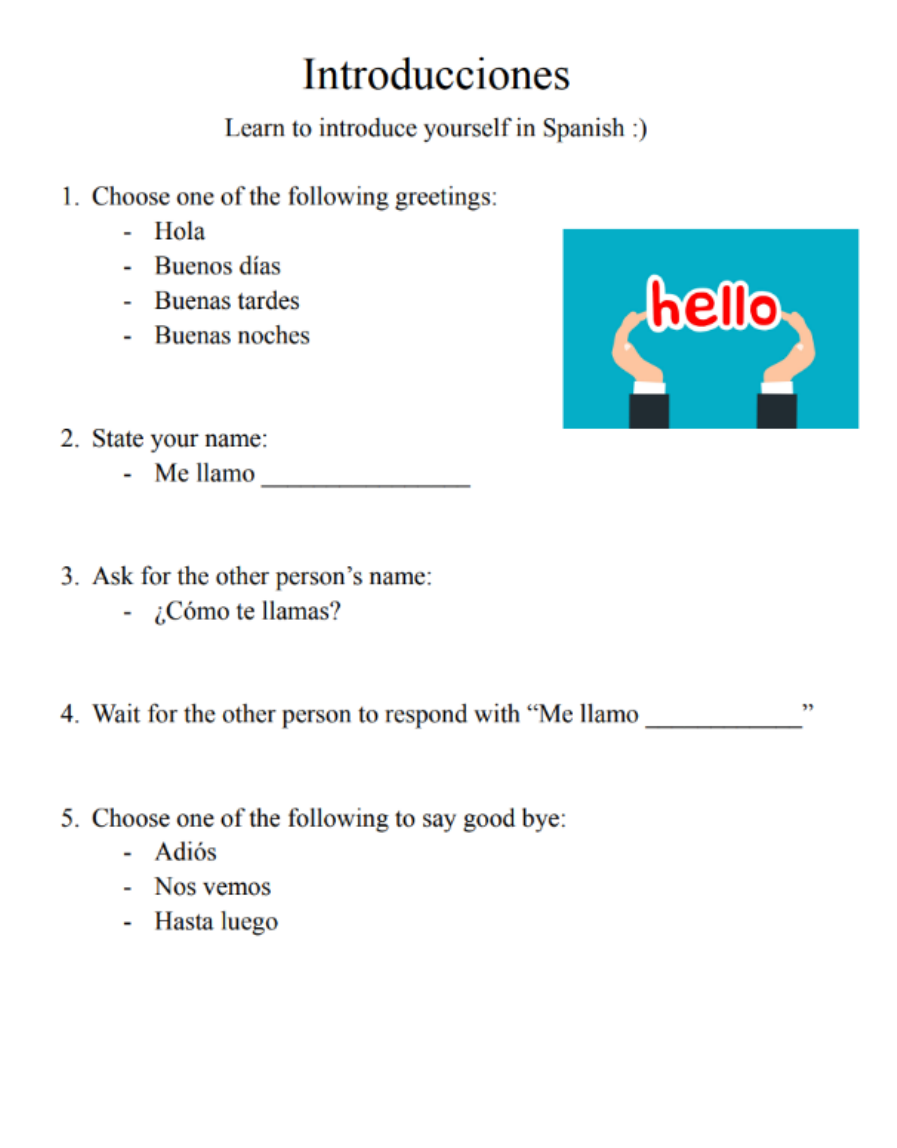
EXPLORADORES DE IDIOMAS: HIGH SCHOOL LED SPANISH CLASSES 26
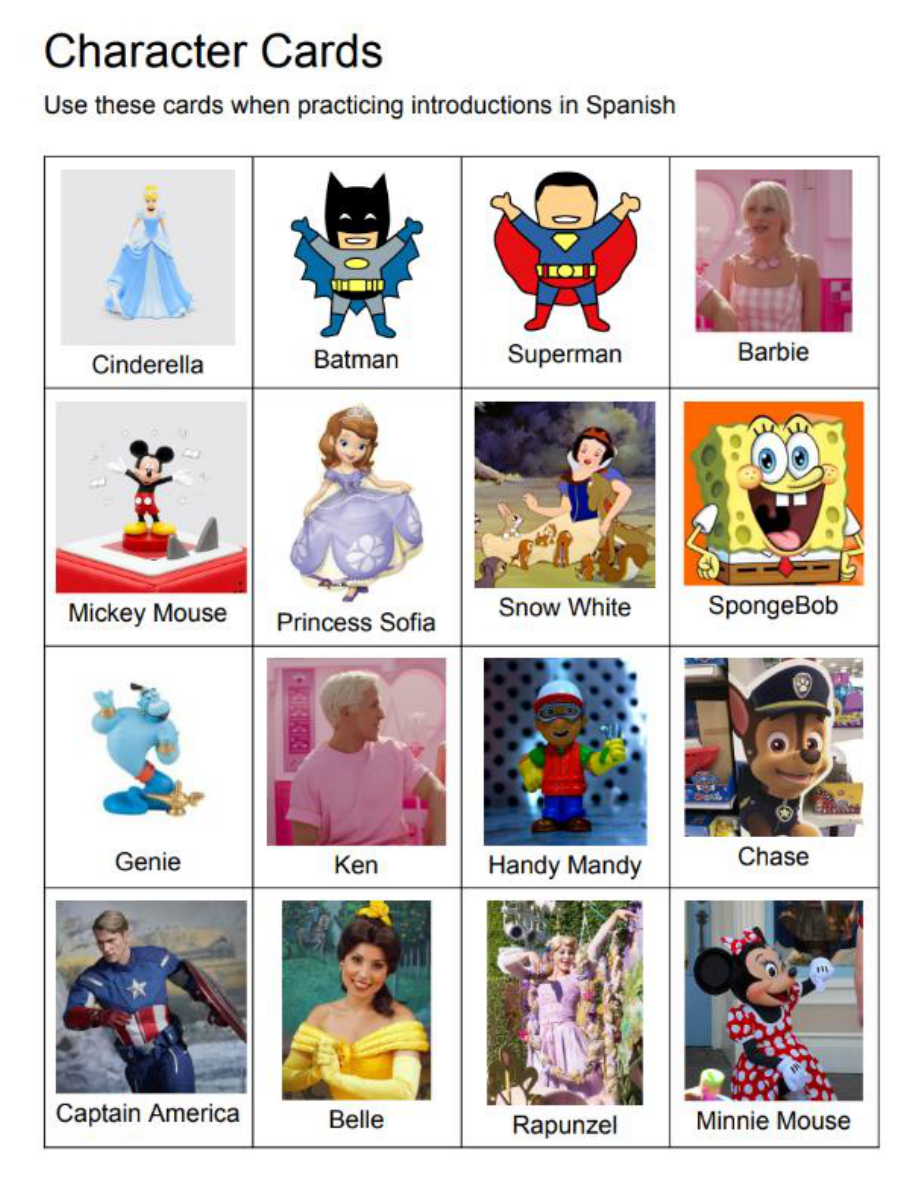
EXPLORADORES DE IDIOMAS: HIGH SCHOOL LED SPANISH CLASSES 27
EXPLORADORES DE IDIOMAS: HIGH SCHOOL LED SPANISH CLASSES 28
EDTL 2290/5290I Lesson plan document (adapted from Burke, 2007, 2017)
(to be used when planning paralessons & field lessons)
DO NOT ALTER THIS TEMPLATE
DATE IMPLEMENTED: September/2nd SPAC Lesson
LANGUAGE/LEVEL: Spanish (Novice Low - Novice High)
LESSON TOPIC: Introduccion a la Música Española
GUIDING QUESTION/S: (in the WL)
- ¿Qué son unas canciones populares en Español?
- ¿Quiénes son unas cantantes hispanas?
MATERIALS: (please list all materials, attaching documents, providing links, may
include pictures or pdfs…no Googledocs or hyperlinks)
- YouTube
- Locura de marzo Bracket
- Pen/pencil/marker
Pre-assessment: (if you are grouping students, how you will approach this? Readiness, interest,
learning style, affect/environment?)
The preassessment for this lesson would rely heavily on how the previous lesson went and what
the students are interested in learning. Students can be grouped on readiness based on their
experience with Spanish, their interests in certain topics related to Spanish, or how they learn
best (audio, video, kinesthetic). It is important to consider these topics when deciding what to
teach. I personally feel that many students enjoy learning about Spanish music, however it is
crucial to consider what your students want to learn about and adjust the lesson accordingly.
PROCEDURE: (use outline format and provide details, teacher talk, and examples; mark
transitions when needed)
Introduction: (explain how you will introduce lesson, marking any additional pre-assessment for
readiness, interest, learning style, and/or affect/environment, and list in outline format, also
labeling formative assessment in BLACK BOLD and in parenthesis)
- the teacher will greet students when they arrive to class by saying “hola” and “como
estas?”
- Students will respond to the greeting and question by answering “hola” and “estoy
_____”
- Students will sit down and the teacher will introduce the lesson using the PowerPoint
“Hoy vamos a aprender sobre musica espanola”
EXPLORADORES DE IDIOMAS: HIGH SCHOOL LED SPANISH CLASSES 29
- The teacher will begin by asking students if they know any Spanish songs or artists
already “¿Conoces unas cantantes hispanas ya? ¿Quiénes son? ¿Qué canciones españolas
ya sabes?
- The students will respond with answers similar to “I know Despacito” “I know Daddy
Yankee”
Body: (Explain what you and students will do step by step in outline format, labeling formative
assessment in BLACK BOLD and in parenthesis, break into subsections if necessary)
This lesson uses the music from the 2024 Locura de Marzo by Señora Ashby (see references for
website).
1. The teacher provides students with a sports bracket of 10-12 different Spanish songs (see
attached).
2. The teacher instructs students to complete the bracket with the song they like most during
each round after hearing a short clip of each song. “Despues de oir un parte corto de cada
cancion, completa tu sopote deportivo para escoger un ganador”
3. The students listen to a short clip of each of the following songs: Bonita, Amor con
Hielo, Mañana es Too Late, Somos, La Vida es Una, Cuando te Bese, Para Vivirla,
Acróstico, Mejor que Ayer, La América que se Olvida, Volvió a Latir, Ojos Marrones,
Levanta tu Bandera, Contento, Mambo 23, Ojitos Rojos
4. Once the students have listened to the clips once, the teacher plays each clip again, so the
students have a completed bracket with one song winning.
5. The teacher explains that last year, thousands of students from all over the world voted on
the songs in order to reach a winner. “El ano pasado, miles de estudiantes votaron durante
esta competicion para selecionar una cancion para ganar”
6. The teacher collects the brackets and tells the students that she will look them over and
see if anyone got the bracket or winner correct before the next class. “Voy a ver si algun
estudiante seleciono el ganador real”
7. After collecting the brackets, the teacher introduces the next part of the music lesson;
Zumba!
8. The teacher says, “hoy vamos a aprender bailar Zumba. Zumba viene de Colombia y es
un estilo de baile.”
9. The teacher shows the students the Mambo 23 Zumba video (see slide 5 in Musica
Espanola PowerPoint)
10. If there is extra time, the teacher can show students another Zumba video (see slides 6
and 7 in Musica Espanola PowerPoint)
Wrap-up/Conclusion: (How did you conclude the lesson? Label formative assessment in
BLACK BOLD and in parenthesis)
- The teacher asks students to share their favorite song they listened to during class today
and why they liked it “Alguien quiere compartir su cancion favorita de hoy y porque es
su favorita?”
EXPLORADORES DE IDIOMAS: HIGH SCHOOL LED SPANISH CLASSES 30
- Students respond with sentences such as “Me gusta _____ because it has a good beat!”
- After a few students have shared their favorite songs, the teacher says goodbye to the
students “Adios chicos y chicas! Nos vemos la proxima clase”
Follow-up: (How could you follow this lesson up? Label formative assessment in BLACK
BOLD in parenthesis)
If students responded well and enjoyed the music from this lesson, the teacher can incorporate
more music into future lessons (especially around Christmas). The teacher should also suggest
that students follow and vote in L’octrubre during the month of October so that they can learn
new Spanish music.
DIFFERENTIATION: (accommodations for all learners with content, process, or product
during lesson based on interest, readiness, learning style, affect/environment)
Students are provided with spoken instructions and examples for auditory learners. Students are
also encouraged to participate in the speaking activity for kinesthetic learners. Finally, students
are shown models and given a handout with directions for visual learners. Additionally, the
songs selected should be interesting for students of all ages.
FORMATIVE ASSESSMENT, PERFORMANCE or PRODUCT for this lesson (must be
evident in procedure, briefly explained here and attached):
Students answered basic questions, such as “Como estas?”. Students also answered questions
about what songs or Spanish artists they already know. During the procedure, students completed
the Locura de Marzo bracket and learned to Zumba to at least one Spanish song. Students said
goodbye to peers and teachers in Spanish as they left.
LEARNING TARGETS: (3 parts) (list with bullet points)
Knowledge and content
Students will understand…
● Rythm of different Spanish songs
● Lyrics to different Spanish songs
Skills and habits
Students will practice and be able to…

EXPLORADORES DE IDIOMAS: HIGH SCHOOL LED SPANISH CLASSES 31
● Dance Zumba to at least one Spanish song
● Sing along to a few different Spanish songs
Character and community (refer to Expeditionary Learning design principles:
https://eleducation.org/resources/design-principles)
Students will practice and develop qualities of…
● Collaboration and competition because students are creating their own bracket for
Spanish music in order to see which Spanish song wins.
● Diversity and inclusion by being involved in a positive classroom environment while
learning to introduce themselves or a character in Spanish while learning more about
their peers.
● Empathy and caring by beginning to develop relationships with their peers through group
work.
● Increase confidence in speaking Spanish with the teacher and peers.
STANDARDS: (Choose the Ohio and National standards that apply to your lesson, including
state and national standards)
National standards are found at:
https://www.actfl.org/sites/default/files/publications/standards/World-
ReadinessStandardsforLearningLanguages.pdf
National standards
● Interpretive Communication: Learners understand, interpret, and analyze what is heard,
read, or viewed on a variety of topics.
● Relating Cultural Products to Perspectives: Learners use the language to investigate,
explain, and reflect on the relationship between the products and perspectives of the
cultures studied.
OH standards are found at: http://education.ohio.gov/getattachment/Topics/Learning-in-
Ohio/Foreign-Language/WL-Draft-Standards-Grid_11x17_April-01-2020.pdf.aspx?lang=en-
US
INT-C.NL.3. Understand a few familiar words or phrases in:
a. Authentic informational texts;
b. Authentic fictional texts;
c. Overheard or observed conversations.
EXPLORADORES DE IDIOMAS: HIGH SCHOOL LED SPANISH CLASSES 32
INT-LIT.NL.1. Recognize cognates and familiar or practiced words, as well as non-traditional
letters, accents, characters or tone marks.
INP-C.NL.5. Express a few basic preferences or feelings.
INP-LIT.NL.4. Infer meaning of unfamiliar language from gestures, facial and body expressions
or context clues during simple interactions.
P-C.NL.5. Express likes and dislikes about very familiar topics from native and other cultures.
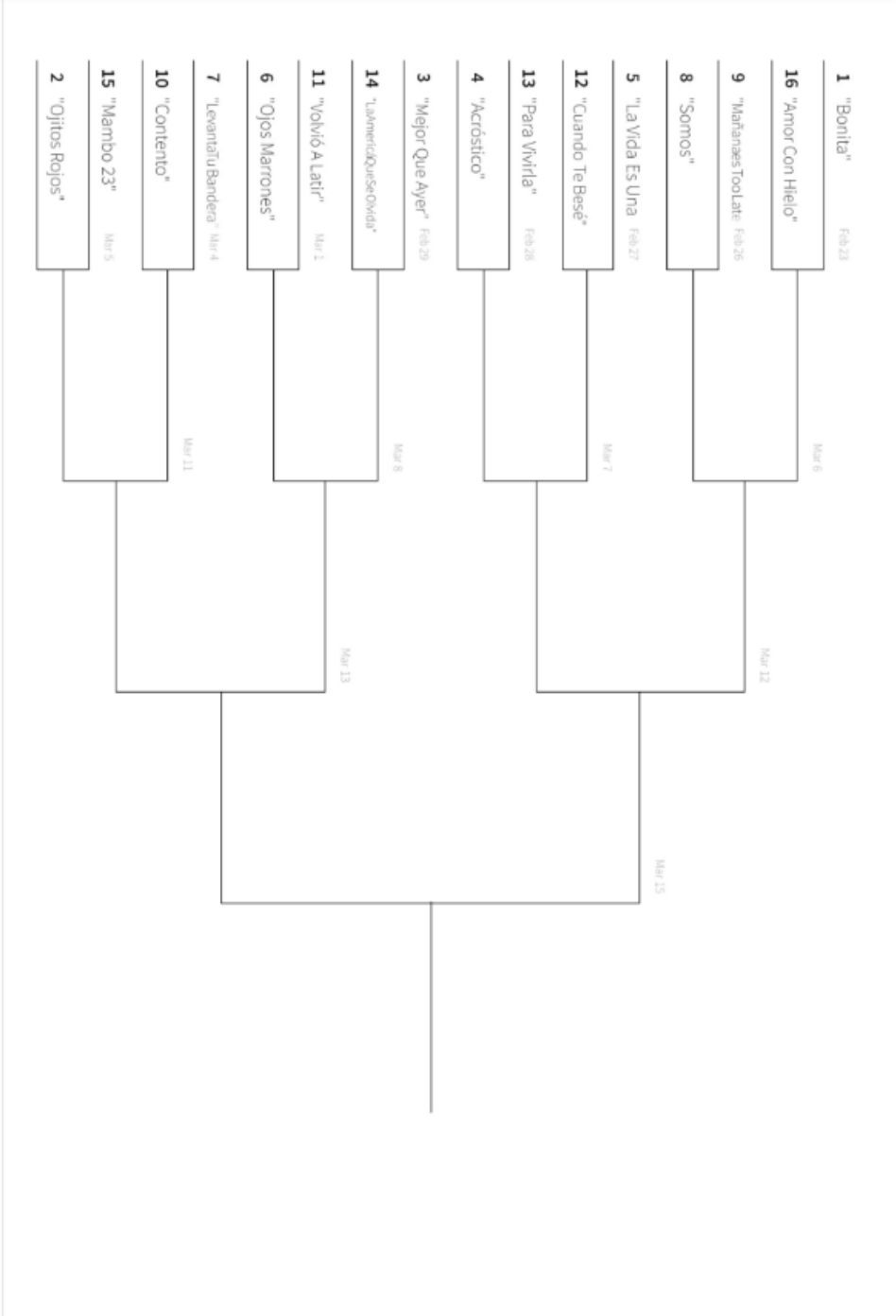
EXPLORADORES DE IDIOMAS: HIGH SCHOOL LED SPANISH CLASSES 33
EXPLORADORES DE IDIOMAS: HIGH SCHOOL LED SPANISH CLASSES 34
EDTL 2290/5290I Lesson plan document (adapted from Burke, 2007, 2017)
(to be used when planning paralessons & field lessons)
DO NOT ALTER THIS TEMPLATE
DATE IMPLEMENTED: October/3rd SPAC Lesson
LANGUAGE/LEVEL: Spanish (Novice Low-Novice High)
LESSON TOPIC: Dia de los Muertos y Halloween
GUIDING QUESTION/S: (in the WL)
- ¿Qué es el Día de los Muertos?
- ¿Cómo celebran Dia de los Muertos?
MATERIALS: (please list all materials, attaching documents, providing links, may
include pictures or pdfs…no Googledocs or hyperlinks)
- Vocabulary recording form
- Ofrenda vocabulary hand out
- How Coco Honors Dia de los Muertos Video
- Post-it Notes
- Markers/Pens/Pencils
Pre-assessment: (if you are grouping students, how you will approach this? Readiness, interest,
learning style, affect/environment?)
The teacher may already know if students have background knowledge in Spanish or topics
related to Spanish based on past classes. Depending on the past classes and students, this lesson
can be adjusted as needed.
During the beginning of class, the teacher will ask students if they know anything about Dia de
Los Muertos. If the students are struggling to come up with ideas, the teacher can also ask if the
students have seen Disney’s Coco in order to help students understand what Dia de los Muertos
is.
PROCEDURE: (use outline format and provide details, teacher talk, and examples; mark
transitions when needed)
Introduction: (explain how you will introduce lesson, marking any additional pre-assessment for
readiness, interest, learning style, and/or affect/environment, and list in outline format, also
labeling formative assessment in BLACK BOLD and in parenthesis)
- the teacher will greet students as they enter by saying “hola” and “como estas?”
- The students will answer by saying “hola” and “estoy _____”
- After all students have entered the classroom the teacher will ask students what they
know about Dia de los Muertos. The teacher can suggest that students think about the
EXPLORADORES DE IDIOMAS: HIGH SCHOOL LED SPANISH CLASSES 35
movie Coco if they are struggling to think of anything they know about Dia de los
Muertos.
- Students could have answers such as, “Dia de los muertos remembers people who have
died” or “Families put up pictures and offerings for Dia de los Muertos”
- The teacher(s) will create an anchor chart on the whiteboard or poster paper for students
to reference during the lesson.
Body: (Explain what you and students will do step by step in outline format, labeling formative
assessment in BLACK BOLD and in parenthesis, break into subsections if necessary)
1. Once students have shared what they already know about Dia de los Muertos, the teacher
will introduce some Halloween vocabulary and Dia de los Muertos vocabulary.
2. Students copy down the vocabulary on their Dia de los Muertos Vocabulary Recording
Form as the teacher goes through each term.
3. Once completed, the students play a Headbands Post-It game where each student receives
a Post-It note with a different vocabulary term on their forehead. Students have to help
one another to guess what vocabulary word is on their forehead.
4. After each student has guessed the vocabulary word on their forehead, the students can
play another round of this game if there is time remaining.
Wrap-up/Conclusion: (How did you conclude the lesson? Label formative assessment in
BLACK BOLD and in parenthesis)
- To end class, students watch a brief video about how the movie Coco honors Dia de los
Muertos
- After the video, students can play another quick round of Headband Post-Its if there is
time remaining.
- As students are leaving class, the teacher says goodbye to the students “Adios chicos y
chicas! Nos vemos la proxima clase”
Follow-up: (How could you follow this lesson up? Label formative assessment in BLACK
BOLD in parenthesis)
This lesson could be followed up by talking about other traditional holidays in Spanish-speaking
countries, such as Christmas, Three Kings Day, Carnaval, etc. This lesson could also be followed
up by talking about other movies that have aspects from Hispanic culture, such as The Road to El
Dorado or Wish.
DIFFERENTIATION: (accommodations for all learners with content, process, or product
during lesson based on interest, readiness, learning style, affect/environment)
Students are provided with spoken instructions and examples for auditory learners. Students are
also encouraged to participate in the speaking activity for kinesthetic learners. Finally, students
are shown models and given a handout with directions for visual learners. Students should have
some prior knowledge of Dia de los Muertos, therefore they should be able to understand the

EXPLORADORES DE IDIOMAS: HIGH SCHOOL LED SPANISH CLASSES 36
topics and vocabulary for this lesson (readiness). Additionally, students should be interested in
this lesson, especially the movie Coco since it is most likely a movie that many of the students
have already watched.
FORMATIVE ASSESSMENT, PERFORMANCE or PRODUCT for this lesson (must be
evident in procedure, briefly explained here and attached):
Students complete the Halloween vocabulary recording form by writing the Spanish word next to
the picture it refers to. After completing the recording form, students participate in a post-it note
heads up speaking activity where each student is given a post-it note with a vocabulary word on
it to stick to their forehead. The goal of this activity is to have students guess what vocabulary
word is on their head.
LEARNING TARGETS: (3 parts) (list with bullet points)
Knowledge and content
Students will understand…
● What Dia de los Muertos is
● How Dia de los Muertos is celebrated
● Basic vocabulary related to Dia de los Muertos and Halloween
Skills and habits
Students will practice and be able to…
● State basic facts about Dia de los Muertos, such as when it is celebrated and where it is
celebrated
● Identify different cultural items used for Ofrendas
Character and community (refer to Expeditionary Learning design principles:
https://eleducation.org/resources/design-principles)
Students will practice and develop qualities of…
● The having of wonderful ideas because students foster curiosity about holidays in
different countries around the world. Students have time to think about how Halloween
might be celebrated in different countries during this lesson, and then make sense of what
they learn at the end of the lesson.
● Diversity and inclusion by being involved in a positive classroom environment while
learning to introduce themselves or a character in Spanish while learning more about
their peers.

EXPLORADORES DE IDIOMAS: HIGH SCHOOL LED SPANISH CLASSES 37
● Empathy and caring by beginning to develop relationships with their peers through group
work.
● Increase confidence in speaking Spanish with the teacher and peers.
STANDARDS: (Choose the Ohio and National standards that apply to your lesson, including
state and national standards)
National standards are found at:
https://www.actfl.org/sites/default/files/publications/standards/World-
ReadinessStandardsforLearningLanguages.pdf
National Standards:
● Interpersonal Communication: Learners interact and negotiate meaning in spoken,
signed, or written conversations to share information, reactions, feelings, and opinions.
● Interpretive Communication: Learners understand, interpret, and analyze what is heard,
read, or viewed on a variety of topics.
● Relating Cultural Practices to Perspectives: Learners use the language to investigate,
explain, and reflect on the relationship between the practices and perspectives of the
cultures studied.
● Acquiring Information and Diverse Perspectives: Learners access and evaluate
information and diverse perspectives that are available through the language and its
cultures.
● Cultural Comparisons: Learners use the language to investigate, explain, and reflect on
the concept of culture through comparisons of the cultures studied and their own.
OH standards are found at: http://education.ohio.gov/getattachment/Topics/Learning-in-
Ohio/Foreign-Language/WL-Draft-Standards-Grid_11x17_April-01-2020.pdf.aspx?lang=en-
US
OH Standards:
INT-C.NL.2. Recognize a few very simple behaviors in other cultures.
INT-C.NL.3. Understand a few familiar words or phrases in:
a. Authentic informational texts;
b. Authentic fictional texts;
c. Overheard or observed conversations.
INT-LIT.NL.1. Recognize cognates and familiar or practiced words, as well as non-traditional
letters, accents, characters or tone marks.
INP-C.NL.1. Identify a few typical products and practices related to familiar, everyday life in
native and other cultures.
INP-C.NL.3. Provide basic information on very familiar topics.
EXPLORADORES DE IDIOMAS: HIGH SCHOOL LED SPANISH CLASSES 38
INP-LIT.NL.1. Use familiar, relevant vocabulary and structures and rehearsed or imitated
cultural behaviors to communicate, react and show interest.
INP-LIT.NL.4. Infer meaning of unfamiliar language from gestures, facial and body expressions
or context clues during simple interactions.
P-C.NL.3. Name very familiar people, places and objects.
P-LIT.NL.3. Communicate with emerging awareness of pronunciation, spelling, mechanics,
hand shapes or signing parameters to increase comprehensibility.
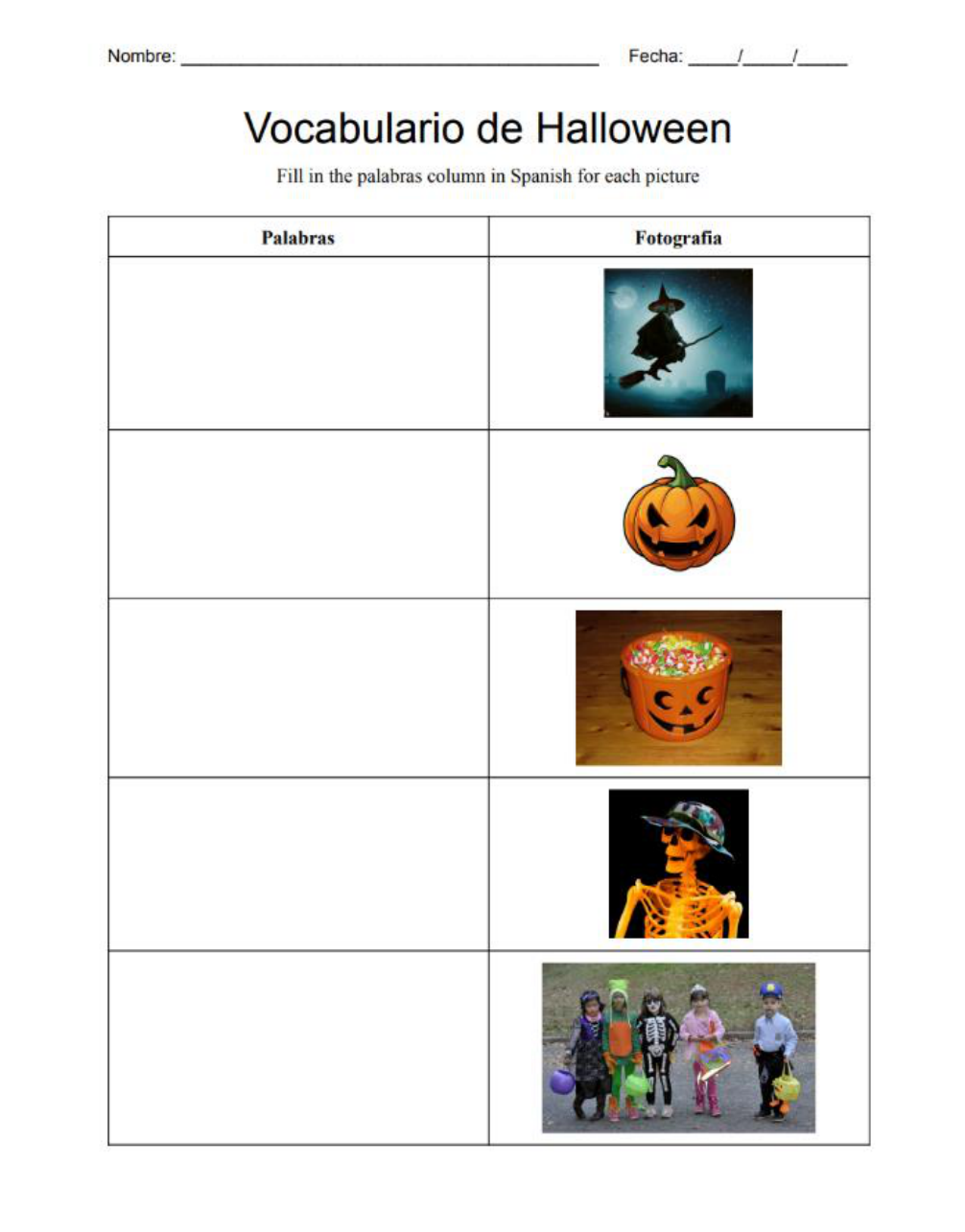
EXPLORADORES DE IDIOMAS: HIGH SCHOOL LED SPANISH CLASSES 39
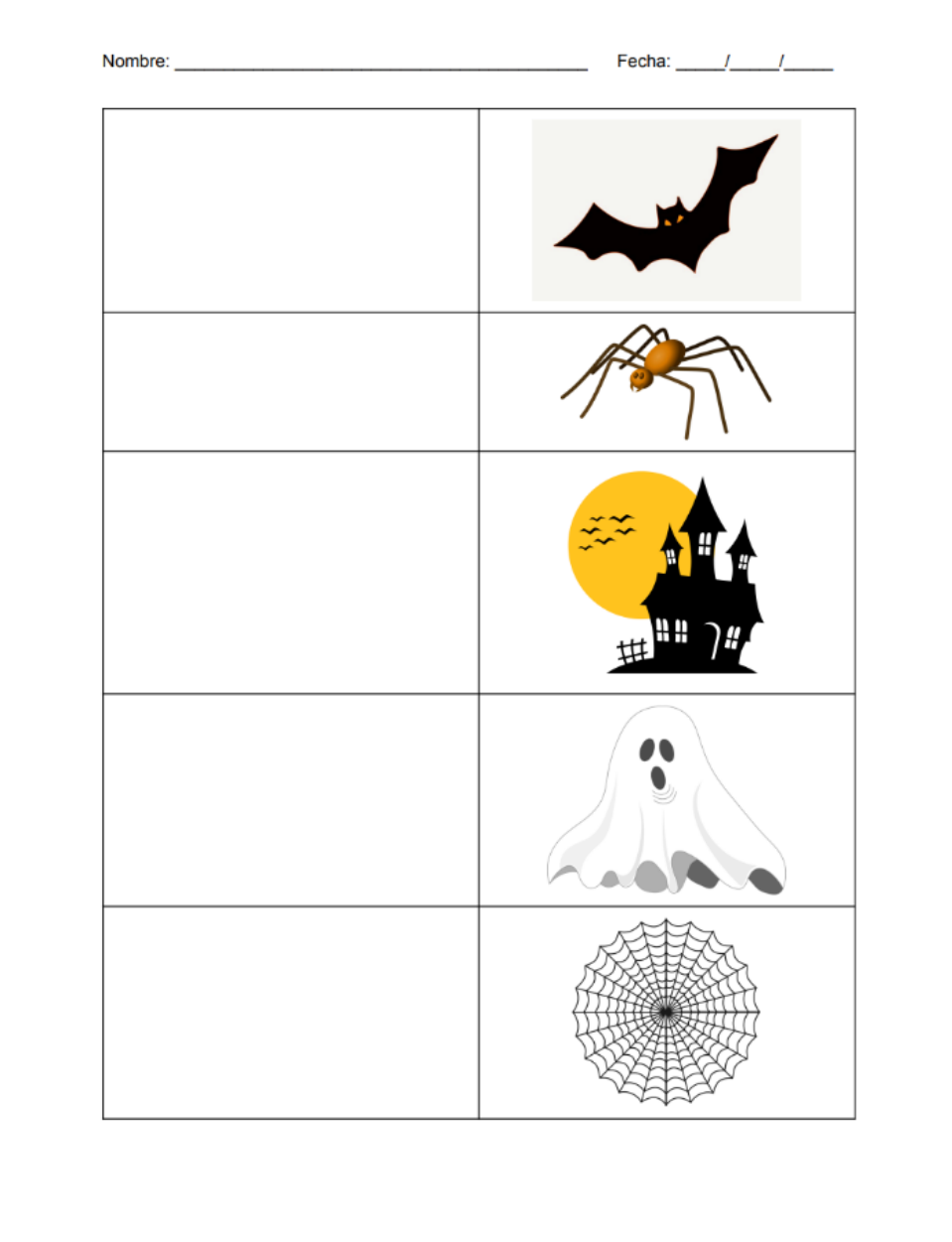
EXPLORADORES DE IDIOMAS: HIGH SCHOOL LED SPANISH CLASSES 40

EXPLORADORES DE IDIOMAS: HIGH SCHOOL LED SPANISH CLASSES 41
EXPLORADORES DE IDIOMAS: HIGH SCHOOL LED SPANISH CLASSES 42
EDTL 2290/5290I Lesson plan document (adapted from Burke, 2007, 2017)
(to be used when planning paralessons & field lessons)
DO NOT ALTER THIS TEMPLATE
DATE IMPLEMENTED: November/ 4th SPAC Lesson
LANGUAGE/LEVEL: Spanish (Novice Low-Novice High)
LESSON TOPIC: Defile de Moda
GUIDING QUESTION/S: (in the WL)
MATERIALS: (please list all materials, attaching documents, providing links, may
include pictures or pdfs…no Googledocs or hyperlinks)
- Thrifted clothes
- Ropa recording form
- Markers/pens/pencils
Pre-assessment: (if you are grouping students, how you will approach this? Readiness, interest,
learning style, affect/environment?)
The teacher may already know if students have background knowledge in Spanish or topics
related to Spanish based on past classes (readiness). Depending on the past classes and students,
this lesson can be adjusted as needed. The teacher can also ask students if they know how to say
any clothing items in Spanish before starting the lesson. Some students may know the word
Sombrero.
PROCEDURE: (use outline format and provide details, teacher talk, and examples; mark
transitions when needed)
Introduction: (explain how you will introduce lesson, marking any additional pre-assessment for
readiness, interest, learning style, and/or affect/environment, and list in outline format, also
labeling formative assessment in BLACK BOLD and in parenthesis)
- The teacher will greet students as they enter by saying “hola” and “como estas?”
- The students will answer by saying “hola” and “estoy _____”
- The teacher begins the class by showing students pictures of different clothing items and
asking them what the items are called in English
- After going through all the different items, the teacher will ask students if they know any
clothing items in Spanish
- If students can not think of any, the teacher will show a picture of a sombrero to see if
students know what the item is called.
EXPLORADORES DE IDIOMAS: HIGH SCHOOL LED SPANISH CLASSES 43
- Once the warm-up activity is completed, the teacher will explain that we are going to be
learning about clothing items today and have a fun activity at the end of class.
Body: (Explain what you and students will do step by step in outline format, labeling formative
assessment in BLACK BOLD and in parenthesis, break into subsections if necessary)
- The teacher will begin the lesson by having students fill in the Ropa recording form
based on the Ropa de Desfile PowerPoint (see attached).
- Once students have completed the recording form, they will cut out each clothing item
from the recording form.
- While students are cutting out the different clothing items, the teacher will pass out a zip
lock bag to each student and a copy of the Doll Handout.
- After the students have finished cutting out their materials, the students will practice this
vocabulary by dressing up the dolls on the handout with the different clothing items as
stated by the teacher. An example of this could be, “pon la camisa roja”
- Then students will check their work with the class.
Wrap-up/Conclusion: (How did you conclude the lesson? Label formative assessment in
BLACK BOLD and in parenthesis)
- After a few rounds of practice with the paper cutouts, the teacher will then introduce the
fashion show to the students.
- Students will have the opportunity to choose their outfit one group at a time from the
thrifted bin of clothes.
- Once the group has their outfits, they will walk around the classroom and say the clothing
items that they are wearing in Spanish using the following functional chunk: “Yo
llevo…”
- After all the students have gone, the class will pack up for the day and describe the outfits
they wore to class as their exit ticket as they walk out the door.
Follow-up: (How could you follow this lesson up? Label formative assessment in BLACK
BOLD in parenthesis)
This lesson could be followed up by talking about traditional clothing in different Spanish-
speaking countries, such as flamenco dresses. Students could read a short article about different
traditional clothes and then create a poster that shows the clothing and its history.
DIFFERENTIATION: (accommodations for all learners with content, process, or product
during lesson based on interest, readiness, learning style, affect/environment)
Students are provided with spoken instructions and examples for auditory learners. Students are
also encouraged to participate in the speaking activity for kinesthetic learners. Finally, students
are shown models and given a handout with directions for visual learners.

EXPLORADORES DE IDIOMAS: HIGH SCHOOL LED SPANISH CLASSES 44
FORMATIVE ASSESSMENT, PERFORMANCE or PRODUCT for this lesson (must be
evident in procedure, briefly explained here and attached):
Formative assessment for this lesson are the students use of learned clothing vocabulary, such as
camisa, vestido, etc. during the fashion show. Students will dress up using clothes provided and
then walk around the classroom while saying the name of the clothing item they are wearing in
Spanish.
LEARNING TARGETS: (3 parts) (list with bullet points)
Knowledge and content
Students will understand…
● Clothing vocabulary in Spanish
● Color vocabulary in Spanish
Skills and habits
Students will practice and be able to…
● Describe clothing items in Spanish
● Identify different colors in Spanish
Character and community (refer to Expeditionary Learning design principles:
https://eleducation.org/resources/design-principles)
Students will practice and develop qualities of…
● Diversity and inclusion by being involved in a positive classroom environment while
learning to introduce themselves or a character in Spanish while learning more about
their peers.
● Empathy and caring by beginning to develop relationships with their peers through group
work.
● Increase confidence in speaking Spanish with the teacher and peers.
STANDARDS: (Choose the Ohio and National standards that apply to your lesson, including
state and national standards)
National standards are found at:
https://www.actfl.org/sites/default/files/publications/standards/World-
ReadinessStandardsforLearningLanguages.pdf

EXPLORADORES DE IDIOMAS: HIGH SCHOOL LED SPANISH CLASSES 45
● Interpretive communication: learners understand, interpret, and analyze what is heard,
read, or viewed on a variety of topics.
● Presentational communication: learned present information, concepts, and ideas to
inform, explain, persuade, and narrate on a variety of topics using appropriate media and
adapting to various audiences of listeners, readers, or viewers.
● Language comparisons: learners use the language to investigate, explain, and reflect on
the nature of language through comparisons of the language studied and their own.
OH standards are found at: http://education.ohio.gov/getattachment/Topics/Learning-in-
Ohio/Foreign-Language/WL-Draft-Standards-Grid_11x17_April-01-2020.pdf.aspx?lang=en-
US
INT-LIT.NL.1. Recognize cognates and familiar or practiced words, as well as non-traditional
letters, accents, characters or tone marks.
INP-LIT.NL.1. Use familiar, relevant vocabulary and structures and rehearsed or imitated
cultural behaviors to communicate, react and show interest.
INP-LIT.NL.4. Infer meaning of unfamiliar language from gestures, facial and body expressions
or context clues during simple interactions.
P-C.NL.2. Present in very familiar intercultural situations using memorized or practiced
language and behaviors.
P-C.NL.3. Name very familiar people, places and objects.
P-LIT.NL.3. Communicate with emerging awareness of pronunciation, spelling, mechanics,
hand shapes or signing parameters to increase comprehensibility.
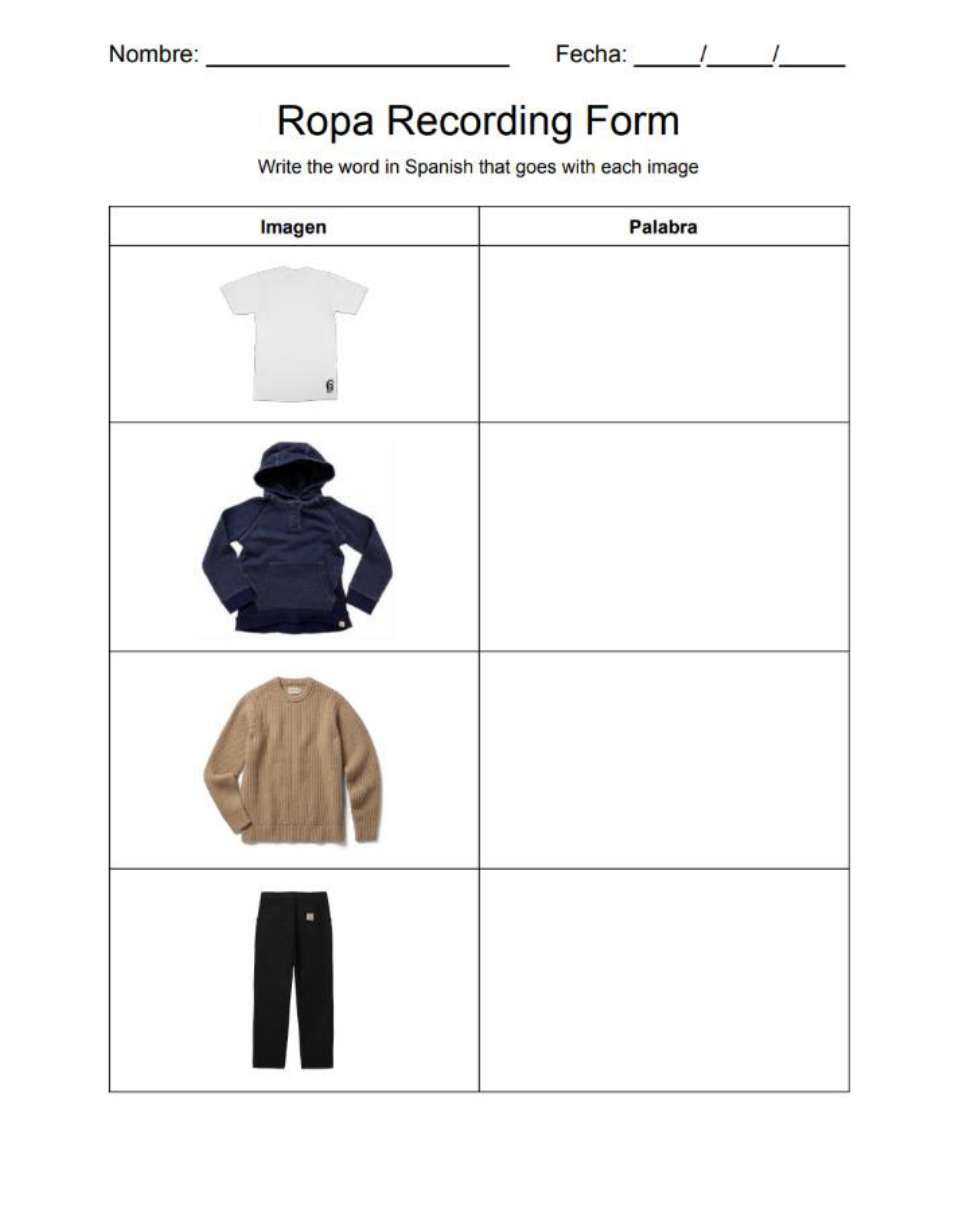
EXPLORADORES DE IDIOMAS: HIGH SCHOOL LED SPANISH CLASSES 46
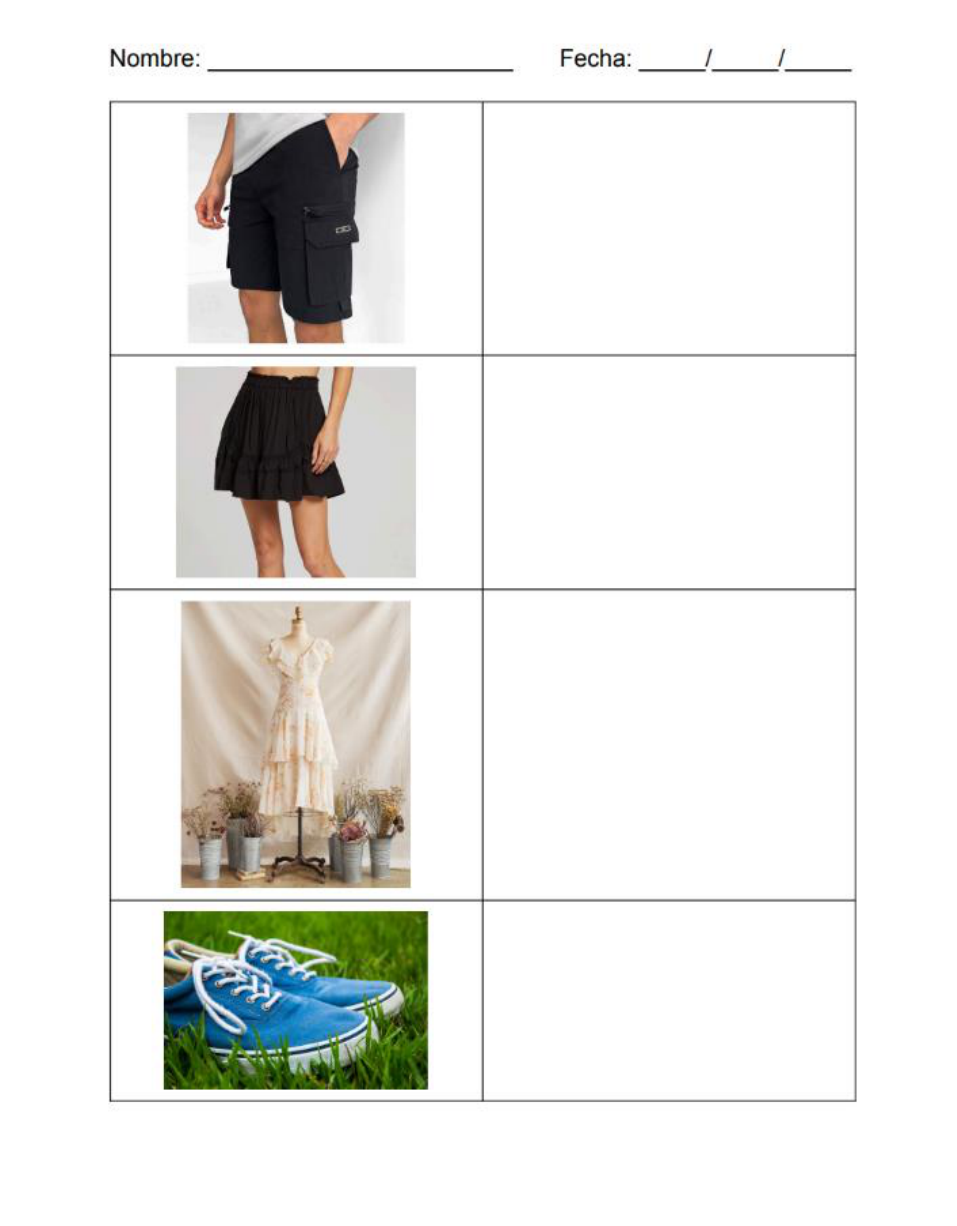
EXPLORADORES DE IDIOMAS: HIGH SCHOOL LED SPANISH CLASSES 47
EXPLORADORES DE IDIOMAS: HIGH SCHOOL LED SPANISH CLASSES 48
EDTL 2290/5290I Lesson plan document (adapted from Burke, 2007, 2017)
(to be used when planning paralessons & field lessons)
DO NOT ALTER THIS TEMPLATE
DATE IMPLEMENTED: December/ 5th SPAC Lesson
LANGUAGE/LEVEL: Spanish (Novice Low-Novice High)
LESSON TOPIC: La Navidad y Dia de los Reyes
GUIDING QUESTION/S: (in the WL)
MATERIALS: (please list all materials, attaching documents, providing links, may
include pictures or pdfs…no Googledocs or hyperlinks)
- Vocabulario de Navidad Recording Form
- Loteria Handouts
- Loose Leaf Paper
- Markers/pens/pencils
- Prize for Loteria
- Colored paper
Pre-assessment: (if you are grouping students, how you will approach this? Readiness, interest,
learning style, affect/environment?)
The teacher may already know if students have background knowledge in Spanish or topics
related to Spanish based on past classes (readiness). Depending on the past classes and students,
this lesson can be adjusted as needed.
Since this is lesson five, the high school students and teacher should know their students well,
therefore they can group the students based on their readiness, interest, learning style, or who
learns best together.
PROCEDURE: (use outline format and provide details, teacher talk, and examples; mark
transitions when needed)
Introduction: (explain how you will introduce lesson, marking any additional pre-assessment for
readiness, interest, learning style, and/or affect/environment, and list in outline format, also
labeling formative assessment in BLACK BOLD and in parenthesis)
- the teacher will greet students as they enter by saying “hola” and “como estas?”
- The students will answer by saying “hola” and “estoy _____”
EXPLORADORES DE IDIOMAS: HIGH SCHOOL LED SPANISH CLASSES 49
- After all students have entered the classroom, the teacher will ask students what they
know about Navidad. The teacher can suggest that students think about Navidad in the
United States in order to have students start comparing the celebrations.
- Students could have answers such as, “Navidad is Christmas! Santa Claus brings presents
to the children.” or “Navidad is celebrated on December 25th”
- The teacher will list the answers on the board or a piece of paper as students share
different ideas in order to reference them later.
Body: (Explain what you and students will do step by step in outline format, labeling formative
assessment in BLACK BOLD and in parenthesis, break into subsections if necessary)
1. Once students have shared all their ideas for what Navidad is and how it is celebrated, the
teacher will introduce some basic vocabulary which consists of the following: regalo,
calendario, jugetes, dulces, carta, barbie, videojuegos, ropa, libro, y carbon.
2. As the teacher goes through the vocabulary, students will fill out their Vocabulario de
Navidad Recording Form.
3. Once done with vocabulary, the students will draft a letter to Santa stating what they want
for Christmas using the following format:
Querido Papa Noel,
Me llamo _____. Soy un/a chico/a con X años. Para Navidad, yo quiero _________.
Muchas gracias,
____________
4. Once students have completed their draft, the students will peer-review one other
students work before the teacher can look over it.
5. After the teacher has checked their work, the students will used colored paper and
markers/pencils to create their final card with their final writing.
6. After completing the final draft, students will share their work with the class.
Wrap-up/Conclusion: (How did you conclude the lesson? Label formative assessment in
BLACK BOLD and in parenthesis)
1. After hearing the comparisons, the teacher will introduce the game Loteria. “Ahora
vamos a jugar Loteria! Es como Bingo. Necesitas tu papel de Loteria y un lapiz”
2. The teacher will randomly say different vocabulary words in Spanish until a student has
“Loteria” (Bingo).
3. The winner receives a reward decided by the students or teachers (maybe candy or a
sticker)
4. If there is extra time, students can play another round of Loteria.
5. As students are leaving class, the teacher says goodbye to the students, “Adios chicos y
chicas! Nos vemos la proxima clase”
Follow-up: (How could you follow this lesson up? Label formative assessment in BLACK
BOLD in parenthesis)

EXPLORADORES DE IDIOMAS: HIGH SCHOOL LED SPANISH CLASSES 50
This lesson could be followed up by taking about three kings day or other holidays in Spanish-
speaking countries. These holidays could be Valentine's Day, Easter, etc. They could also be
country specific holidays, such as Las Fallas in Spain. Students could read a short article
(formative) about the topic and then compare (formative) them to holidays in the United
States.
DIFFERENTIATION: (accommodations for all learners with content, process, or product
during lesson based on interest, readiness, learning style, affect/environment)
Students are provided with spoken instructions and examples for auditory learners. Students are
also encouraged to participate in the speaking activity for kinesthetic learners. Finally, students
are shown models and given a handout with directions for visual learners.
FORMATIVE ASSESSMENT, PERFORMANCE or PRODUCT for this lesson (must be
evident in procedure, briefly explained here and attached):
Students will complete a vocabulary recording form by writing in each vocabulary word next to
the picture that it describes. After completing the recording form, students will write the first
draft of a letter to Santa using the functional chunk “yo quiero”. This letter can be in Spanglish,
however students should use the vocabulary learned in class. After writing their first draft,
students will then peer-review their letters and let the teacher check it before creating their final
card. If time remaining, students will play Loteria, which is like Spanish bingo.
LEARNING TARGETS: (3 parts) (list with bullet points)
Knowledge and content
Students will understand…
● How Navidad is celebrated in Spain
● What Dia de los Reyes is and how it is celebrated in Spain
● What Loteria is and when it is celebrated in Spain
Skills and habits
Students will practice and be able to…
● Explain how Navidad and Dia de los Reyes are celebrated in Spain
● Use basic Christmas vocabulary, such as regalo, libro, dulces, ropa, etc.
Character and community (refer to Expeditionary Learning design principles:
https://eleducation.org/resources/design-principles)

EXPLORADORES DE IDIOMAS: HIGH SCHOOL LED SPANISH CLASSES 51
Students will practice and develop qualities of…
● Diversity and inclusion by being involved in a positive classroom environment while
learning to introduce themselves or a character in Spanish while learning more about
their peers.
● Empathy and caring by beginning to develop relationships with their peers through group
work.
● Increase confidence in speaking Spanish with the teacher and peers.
STANDARDS: (Choose the Ohio and National standards that apply to your lesson, including
state and national standards)
National standards are found at:
https://www.actfl.org/sites/default/files/publications/standards/World-
ReadinessStandardsforLearningLanguages.pdf
National standards:
● Interpersonal Communication: Learners interact and negotiate meaning in spoken,
signed, or written conversations to share information, reactions, feelings, and opinions.
● Interpretive Communication: Learners understand, interpret, and analyze what is heard,
read, or viewed on a variety of topics.
● Relating Cultural Practices to Perspectives: Learners use the language to investigate,
explain, and reflect on the relationship between the practices and perspectives of the
cultures studied.
● Acquiring Information and Diverse Perspectives: Learners access and evaluate
information and diverse perspectives that are available through the language and its
cultures.
OH standards are found at: http://education.ohio.gov/getattachment/Topics/Learning-in-
Ohio/Foreign-Language/WL-Draft-Standards-Grid_11x17_April-01-2020.pdf.aspx?lang=en-
US
OH standards:
INT-C.NL.2. Recognize a few very simple behaviors in other cultures.
INT-LIT.NL.1. Recognize cognates and familiar or practiced words, as well as non-traditional
letters, accents, characters or tone marks.
INT-LIT.NL.4. Make personal connections to a text using prior knowledge or experiences.
INP-C.NL.5. Express a few basic preferences or feelings.
INP-LIT.NL.1. Use familiar, relevant vocabulary and structures and rehearsed or imitated
cultural behaviors to communicate, react and show interest.
EXPLORADORES DE IDIOMAS: HIGH SCHOOL LED SPANISH CLASSES 52
INP-LIT.NL.4. Infer meaning of unfamiliar language from gestures, facial and body expressions
or context clues during simple interactions.
P-C.NL.4. Provide very basic details about self.
P-LIT.NL.1. Use authentic resources and familiar vocabulary and structures that are relevant to
the topic

EXPLORADORES DE IDIOMAS: HIGH SCHOOL LED SPANISH CLASSES 53

EXPLORADORES DE IDIOMAS: HIGH SCHOOL LED SPANISH CLASSES 54
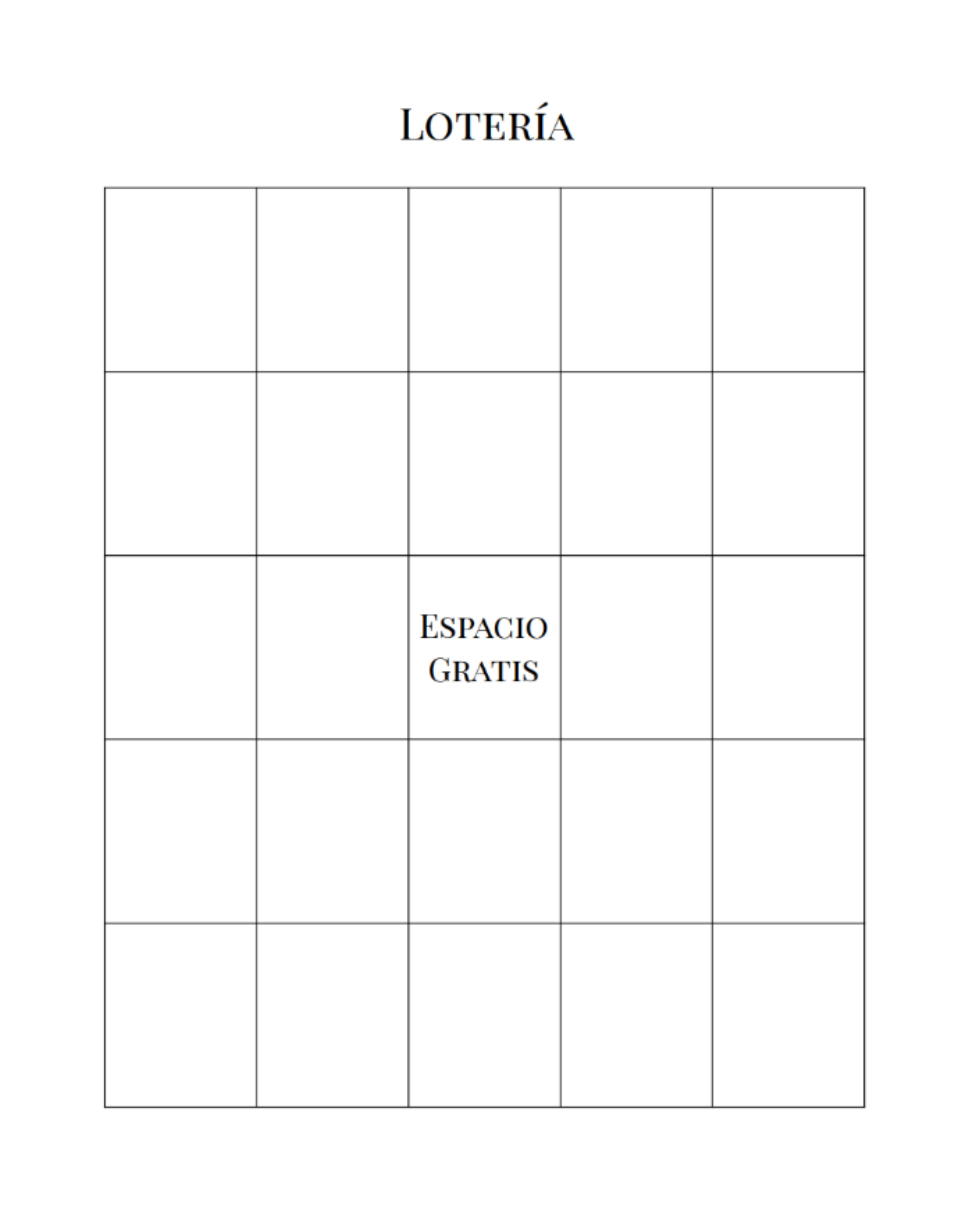
EXPLORADORES DE IDIOMAS: HIGH SCHOOL LED SPANISH CLASSES 55
